 |
| Category: Army
History/WW2 |

|
|
|
|
|
|
Volunteer
Defence Corps (WW2)
|
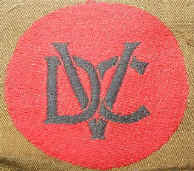
|
|
The body that had the
greatest effect upon the organisation of the army was the Volunteer
Defence Corps.
It was inaugurated on 15 July 1940 under the auspices of the
Returned Sailors', Soldiers', and Airmen's Imperial League of
Australia (RSSAILA now RSL)
|
| Four types of VDC (Corporal Tom
Goodall, Corporal Joseph Gill and Sergeant Alfred Thomson). A
pen and ink and water-colour by Tony Rafty, created at
Queenscliff 1943 |
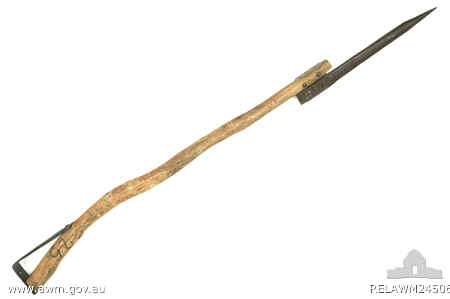 |
Australian practice
rifle made with bush timber and has an iron butt. The butt is
stamped 25.
It is complete with bayonet,
stamped XXV, and scabbard, capable of being unfixed and was made
from part of a reaping machine.
This rifle was made by Captain
Leonard Cariston Seton, of 29 Battalion, Volunteer Defence
Corps, Moree. |
| A
number of rifles of this type were improvised for used by the
Graman Platoon for training in rifle exercises, fixing and
unfixing bayonets and bayonet practice. The rifles were only one
of a variety of weapons improvised by Captain Seton, who has
stated that the improvisations ranged from a prismatic compass
to machine guns. |
|
Volunteer Defence Corps numbers in 1944
|
| Line
of Communications Area |
No.
of VDC Battalions |
Full
time personnel |
Active
part-time personnel |
Reserve
part-time personnel |
Total
personnel |
| Queensland |
23 |
547 |
4,008 |
8,053 |
12,608 |
| New
South Wales |
33 |
498 |
11,472 |
10,730 |
22,970 |
| Victoria |
24 |
154 |
5,444 |
13,585 |
19,183 |
| South
Australia |
10 |
68 |
2,983 |
4,194 |
7,245 |
| Western
Australia |
16 |
130 |
5,037 |
4,343 |
9,510 |
| Tasmania |
3 |
88 |
1,222 |
2,348 |
3,658 |
| Total/s |
111 |
1,485 |
30,166 |
43,253 |
75,174 |
|
The
Volunteer Defence Corps
During the war, a number of
private- or government-sponsored movements emerged to assist
the war effort. Some, such as the Australian Red Cross or the
Salvation Army, had peacetime functions, which these
organisations redefined as wartime aid to the nation's service
men and women. Others were new entities, for example, the
Australian Women's Land Army.
The body that had the
greatest effect upon the organisation of the army was the Volunteer
Defence Corps.
It was inaugurated on 15 July 1940 under the auspices of the
Returned Sailors', Soldiers', and Airmen's Imperial League of
Australia (RSSAILA now RSL)
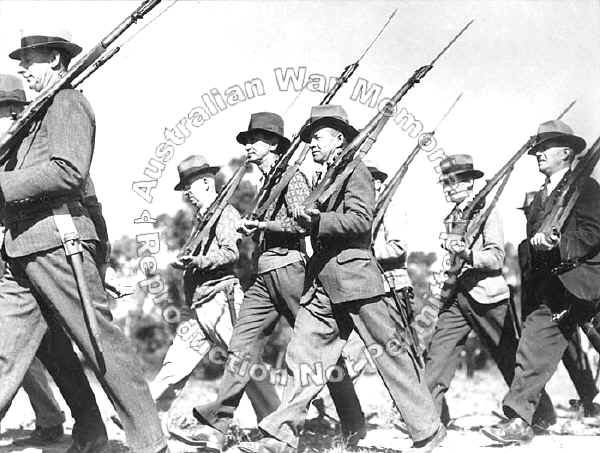 |
| Australia. 1942. The
Volunteer Defence Corps (VDC) was raised and maintained
in its early years by the RSL and later handed over to
Army control. It comprised men from every part of
Australia and every walk of civilian life - volunteers
unfit for combat in the regular forces, over the age
limit or in reserved occupations. VDC members are shown
marching with rifles over their shoulders, training
before the issue of uniforms. |
Its founding principle was
to provide a means by which ex-servicemen could make a
contribution to the defence of their communities.
- In May 1941, the
Volunteer Defence Corps became part of the army.
- The following year,
it became a Corps of the CMF
Once it was under the
government's control, the government expanded its membership
in order to allow fit males who were in reserved occupations
the opportunity to perform some military duty. By September
1942, only 20 per cent of the Volunteer Defence Corps had seen
previous service.
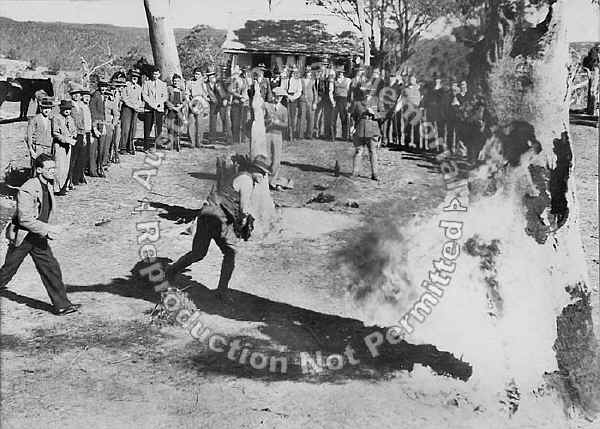 |
| Australia. c. 1942.
Volunteer Defence Corps (VDC) members conduct an
incendiary exercise using home made bombs. The VDC was
to engage in guerilla warfare to the best of its ability
should the Japanese invade the country. |
The army defined the
objective of the Volunteer Defence Corps as to 1 augment the
local defences of the State by providing static defence of
localities and the protection of vulnerable points and by
giving timely information regarding enemy movements to
superior military organizations More succinctly, its purpose
was to
'Deny,
Delay, and Protect'.
Some of the particular
missions for which the Volunteer Defence Corps prepared
included the construction of road blocks, demolition of
bridges and piers, protection of airbases, industrial sites,
and vulnerable points, coastwatching, and village and
guerrilla warfare. When workers joined the organisation, they
often provided for the defence of their plants.
- For example, protecting
the BHP steel works at Newcastle were three Volunteer Defence
Corps battalions, each representing an eight-hour shift.
When the manpower situation became difficult, the
Volunteer Defence Corps expanded its role, especially in
the manning of anti-aircraft batteries and coast defence
fortifications.
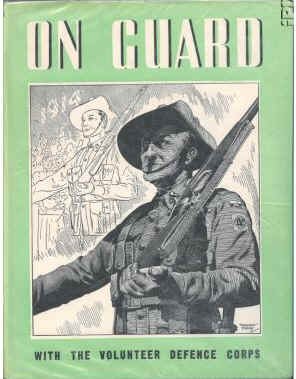
Anzac Day
arm band RSL/VDC >>>
|
So that the Volunteer
Defence Corps could achieve its mission, the army organised it
geographically to correspond to the line of communication
areas.
In each Line of
Communication Area, the army appointed
a Volunteer Defence Corps commander.
It then subdivided each
line of communication area into Volunteer Defence Corps
groups, each holding several battalions.
The army abolished
the group level in 1944.
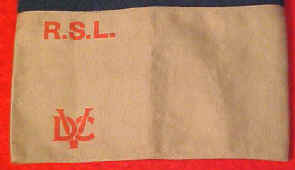
|
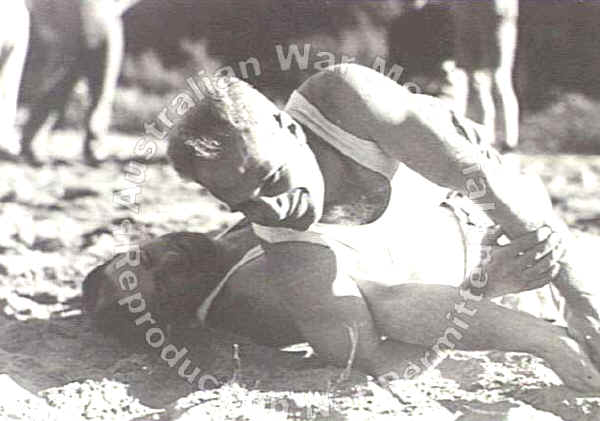 |
| Frankston, Victoria
1942-06-18. Members of the Volunteer Defence Corps (VDC)
at Physical and Recreational Training School, L.H.Q.
Unarmed combat is a part of VDC training. |
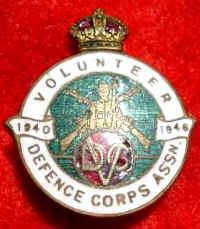 |
- Post war Volunteer
Defence Corps Association badges
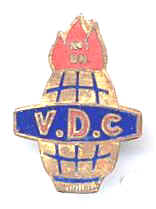
|
A typical battalion held
approximately 400 men, organised into companies, platoons, and
sections. However, the Volunteer Defence Corps did not have
any fixed establishment, as the operational task determined
the shape of a particular unit.
The Volunteer Defence Corps
was responsible for its own administration and training, but
for operational matters it fell under the control of the
officer commanding the Line of Communication Area to which it
belonged.
At each command level, down
to the battalion, the Volunteer Defence Corps contained a
handful of full-time staff to manage administrative and
training matters. Most volunteers served on a part-time basis,
reporting for duty for only about six hours a week. Later in
the war, the army did authorise the recruitment of up to 5,000
Volunteer Defence Corps members for full-time duty to perform
tasks such as coast-watching and the guarding of vulnerable
points, but the number serving continuously never exceeded
3,000.
Part-time and full-time
serving volunteers did, however, allow the army to divert
substantial Line of Communication area troops to other duties.
In 1944, the army had replaced over 6,000 army personnel with
Volunteer Defence Corps staff .
In fact, the Volunteer
Defence Corps was so popular that it attracted far more
members than the army believed could be profitably employed,
and its establishment was as much a product of individual
demand and political advantage as military requirement. When
first absorbed by the army, the Volunteer Defence Corps had an
establishment set at 50,000. Within two months, recruits
oversubscribed the ranks to such an extent that the government
raised the limit to 80,000.
This was still insufficient,
and the Volunteer Defence Corps carried a further 18,000 as
supernumeraries. The government approached Blarney with the
idea of increasing the limit further, but he objected, basing
his argument on the absence of a military need. However,
Blamey's words had little effect on Francis Forde, who had
become Minister for the Army in October 1941. In December
1942, Forde authorised additional expenditure in order to
equip a volunteer force of up to 100,000 men.
While the formation of the
Volunteer Defence Corps provided the army with additional
resources for local defence, especially during the fearful
first half of 1942, it did create some problems for the army.
The most serious was the provision of uniforms and equipment,
as the CMF was desperately short of these items itself. The
army attempted to maintain a policy of issuing materials to
the Volunteer Defence Corps only once it had satisfied the
CMF's demand.
However, the government
found this policy politically unsustainable, and capitulated
to demands for more resources for the volunteers. An appeal
from the Coogee-Randwick Area Returned Sailors', Soldiers'
and Airmen's Imperial League of Australia in September 1940
for uniforms, arms, and equipment was a typical effort by the
volunteers for better access to war goods. In this letter the
Coogee-Randwick veterans noted that their desire was for
sufficient arms so that they might constitute a real fighting
force that was able to serve Australia in case of invasion.
The Minister for the Army at
the time, Spender, had difficulty rejecting such requests, and
instead required the army to provide the volunteers with
greater access to rifles. However, the issuance of other
weapons, such as mortars and grenades, had to wait until the
army had satisfied the demands of higher priority formations.
Consequently, in 1944, when the nation's need for them was
clearly in decline, active-duty Volunteer Defence Corps
battalions were only then reaching an average of approximately
75 per cent of an infantry battalion's equipment
establishment.
Like the rest of the army,
the Volunteer Defence Corps began to contract in 1943. By
December 1943, its strength was down to under 86,000. In July
1944, the army undertook a major reorganisation of the
volunteers. The army placed more than half of its membership
on reserve status. In October 1944, the 1st Army placed 15
Volunteer Defence Corps battalions onto reserve status and
disbanded several other units entirely. The only formation
remaining on active status in the Brisbane area was the 10th
Australian Anti-Aircraft Group, which contained three static
heavy antiaircraft batteries. Shortly after the end of the
war, the army demobilised the entire Volunteer Defence Corps.
The Table
above outlines the organisation of the Volunteer Defence Corps
as it existed in August 1944.
extract from The
Australian Army, Albert Palazzo. Oxford University Press ISBN
019 551507 2
|
|
|